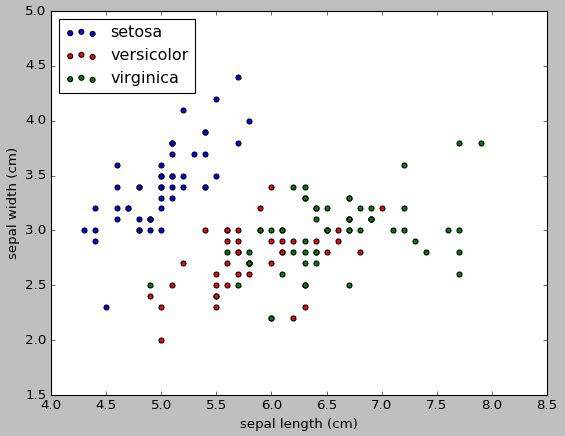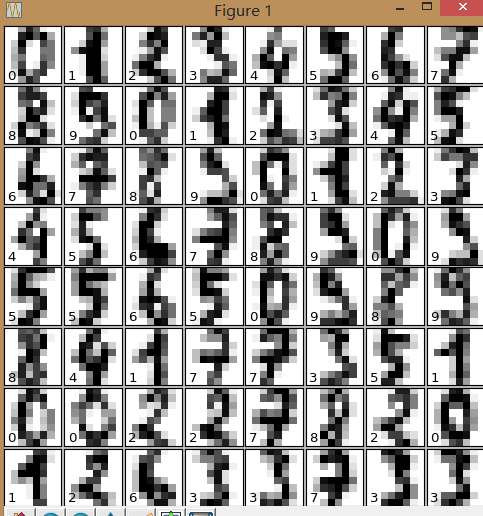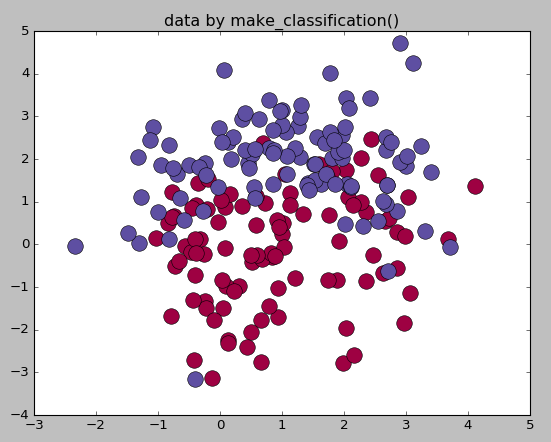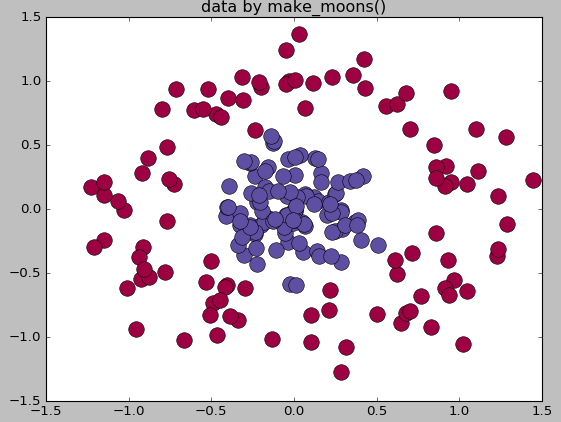机器学习实战基础(十九):sklearn中数据集
sklearn提供的自带的数据集
sklearn 的数据集有好多个种
- 自带的小数据集(packaged dataset):sklearn.datasets.load_<name>
- 可在线下载的数据集(Downloaded Dataset):sklearn.datasets.fetch_<name>
- 计算机生成的数据集(Generated Dataset):sklearn.datasets.make_<name>
- svmlight/libsvm格式的数据集:sklearn.datasets.load_svmlight_file(...)
- 从买了data.org在线下载获取的数据集:sklearn.datasets.fetch_mldata(...)
①自带的数据集
其中的自带的小的数据集为:sklearn.datasets.load_<name>

这些数据集都可以在官网上查到,以鸢尾花为例,可以在官网上找到demo,http://scikit-learn.org/stable/auto_examples/datasets/plot_iris_dataset.html


from sklearn.datasets import load_iris
#加载数据集
iris=load_iris()
iris.keys() #dict_keys(['target', 'DESCR', 'data', 'target_names', 'feature_names'])
#数据的条数和维数
n_samples,n_features=iris.data.shape
print("Number of sample:",n_samples) #Number of sample: 150
print("Number of feature",n_features) #Number of feature 4
#第一个样例
print(iris.data[0]) #[ 5.1 3.5 1.4 0.2]
print(iris.data.shape) #(150, 4)
print(iris.target.shape) #(150,)
print(iris.target)
"""
[0 0 0 0 0 0 0 0 0 0 0 0 0 0 0 0 0 0 0 0 0 0 0 0 0 0 0 0 0 0 0 0 0 0 0 0 0
0 0 0 0 0 0 0 0 0 0 0 0 0 1 1 1 1 1 1 1 1 1 1 1 1 1 1 1 1 1 1 1 1 1 1 1 1
1 1 1 1 1 1 1 1 1 1 1 1 1 1 1 1 1 1 1 1 1 1 1 1 1 1 2 2 2 2 2 2 2 2 2 2 2
2 2 2 2 2 2 2 2 2 2 2 2 2 2 2 2 2 2 2 2 2 2 2 2 2 2 2 2 2 2 2 2 2 2 2 2 2
2 2]
"""
import numpy as np
print(iris.target_names) #['setosa' 'versicolor' 'virginica']
np.bincount(iris.target) #[50 50 50] import matplotlib.pyplot as plt
#以第3个索引为划分依据,x_index的值可以为0,1,2,3
x_index=3
color=['blue','red','green']
for label,color in zip(range(len(iris.target_names)),color):
plt.hist(iris.data[iris.target==label,x_index],label=iris.target_names[label],color=color) plt.xlabel(iris.feature_names[x_index])
plt.legend(loc="Upper right")
plt.show()
#画散点图,第一维的数据作为x轴和第二维的数据作为y轴
x_index=0
y_index=1
colors=['blue','red','green']
for label,color in zip(range(len(iris.target_names)),colors):
plt.scatter(iris.data[iris.target==label,x_index],
iris.data[iris.target==label,y_index],
label=iris.target_names[label],
c=color)
plt.xlabel(iris.feature_names[x_index])
plt.ylabel(iris.feature_names[y_index])
plt.legend(loc='upper left')
plt.show()



手写数字数据集load_digits():用于多分类任务的数据集

from sklearn.datasets import load_digits
digits=load_digits()
print(digits.data.shape)
import matplotlib.pyplot as plt
plt.gray()
plt.matshow(digits.images[0])
plt.show() from sklearn.datasets import load_digits
digits=load_digits()
digits.keys()
n_samples,n_features=digits.data.shape
print((n_samples,n_features)) print(digits.data.shape)
print(digits.images.shape) import numpy as np
print(np.all(digits.images.reshape((1797,64))==digits.data)) fig=plt.figure(figsize=(6,6))
fig.subplots_adjust(left=0,right=1,bottom=0,top=1,hspace=0.05,wspace=0.05)
#绘制数字:每张图像8*8像素点
for i in range(64):
ax=fig.add_subplot(8,8,i+1,xticks=[],yticks=[])
ax.imshow(digits.images[i],cmap=plt.cm.binary,interpolation='nearest')
#用目标值标记图像
ax.text(0,7,str(digits.target[i]))
plt.show()



乳腺癌数据集load-barest-cancer():简单经典的用于二分类任务的数据集
糖尿病数据集:load-diabetes():经典的用于回归认为的数据集,值得注意的是,这10个特征中的每个特征都已经被处理成0均值,方差归一化的特征值,
波士顿房价数据集:load-boston():经典的用于回归任务的数据集
体能训练数据集:load-linnerud():经典的用于多变量回归任务的数据集,其内部包含两个小数据集:Excise是对3个训练变量的20次观测(体重,腰围,脉搏),physiological是对3个生理学变量的20次观测(引体向上,仰卧起坐,立定跳远)
svmlight/libsvm的每一行样本的存放格式:
<label><feature-id>:<feature-value> <feature-id>:<feature-value> ....
这种格式比较适合用来存放稀疏数据,在sklearn中,用scipy sparse CSR矩阵来存放X,用numpy数组来存放Y
from sklearn.datasets import load_svmlight_file
x_train,y_train=load_svmlight_file("/path/to/train_dataset.txt","")#如果要加在多个数据的时候,可以用逗号隔开
②生成数据集
生成数据集:可以用来分类任务,可以用来回归任务,可以用来聚类任务,用于流形学习的,用于因子分解任务的
用于分类任务和聚类任务的:这些函数产生样本特征向量矩阵以及对应的类别标签集合
make_blobs:多类单标签数据集,为每个类分配一个或多个正太分布的点集
make_classification:多类单标签数据集,为每个类分配一个或多个正太分布的点集,提供了为数据添加噪声的方式,包括维度相关性,无效特征以及冗余特征等
make_gaussian-quantiles:将一个单高斯分布的点集划分为两个数量均等的点集,作为两类
make_hastie-10-2:产生一个相似的二元分类数据集,有10个维度
make_circle和make_moom产生二维二元分类数据集来测试某些算法的性能,可以为数据集添加噪声,可以为二元分类器产生一些球形判决界面的数据

#生成多类单标签数据集
import numpy as np
import matplotlib.pyplot as plt
from sklearn.datasets.samples_generator import make_blobs
center=[[1,1],[-1,-1],[1,-1]]
cluster_std=0.3
X,labels=make_blobs(n_samples=200,centers=center,n_features=2,
cluster_std=cluster_std,random_state=0)
print('X.shape',X.shape)
print("labels",set(labels)) unique_lables=set(labels)
colors=plt.cm.Spectral(np.linspace(0,1,len(unique_lables)))
for k,col in zip(unique_lables,colors):
x_k=X[labels==k]
plt.plot(x_k[:,0],x_k[:,1],'o',markerfacecolor=col,markeredgecolor="k",
markersize=14)
plt.title('data by make_blob()')
plt.show()
#生成用于分类的数据集
from sklearn.datasets.samples_generator import make_classification
X,labels=make_classification(n_samples=200,n_features=2,n_redundant=0,n_informative=2,
random_state=1,n_clusters_per_class=2)
rng=np.random.RandomState(2)
X+=2*rng.uniform(size=X.shape) unique_lables=set(labels)
colors=plt.cm.Spectral(np.linspace(0,1,len(unique_lables)))
for k,col in zip(unique_lables,colors):
x_k=X[labels==k]
plt.plot(x_k[:,0],x_k[:,1],'o',markerfacecolor=col,markeredgecolor="k",
markersize=14)
plt.title('data by make_classification()')
plt.show() #生成球形判决界面的数据
from sklearn.datasets.samples_generator import make_circles
X,labels=make_circles(n_samples=200,noise=0.2,factor=0.2,random_state=1)
print("X.shape:",X.shape)
print("labels:",set(labels)) unique_lables=set(labels)
colors=plt.cm.Spectral(np.linspace(0,1,len(unique_lables)))
for k,col in zip(unique_lables,colors):
x_k=X[labels==k]
plt.plot(x_k[:,0],x_k[:,1],'o',markerfacecolor=col,markeredgecolor="k",
markersize=14)
plt.title('data by make_moons()')
plt.show()




机器学习实战基础(十九):sklearn中数据集的更多相关文章
- 机器学习实战基础(九):sklearn中的数据预处理和特征工程(二) 数据预处理 Preprocessing & Impute 之 数据无量纲化
1 数据无量纲化 在机器学习算法实践中,我们往往有着将不同规格的数据转换到同一规格,或不同分布的数据转换到某个特定分布的需求,这种需求统称为将数据“无量纲化”.譬如梯度和矩阵为核心的算法中,譬如逻辑回 ...
- Bootstrap <基础十九>分页
Bootstrap 支持的分页特性.分页(Pagination),是一种无序列表,Bootstrap 像处理其他界面元素一样处理分页. 分页(Pagination) 下表列出了 Bootstrap 提 ...
- 机器学习实战基础(二十九):决策树(二)DecisionTreeClassifier与红酒数据集
DecisionTreeClassifier与红酒数据集 1 sklearn.tree.DecisionTreeClassifier class sklearn.tree.DecisionTreeCla ...
- 机器学习实战基础(十):sklearn中的数据预处理和特征工程(三) 数据预处理 Preprocessing & Impute 之 缺失值
缺失值 机器学习和数据挖掘中所使用的数据,永远不可能是完美的.很多特征,对于分析和建模来说意义非凡,但对于实际收集数据的人却不是如此,因此数据挖掘之中,常常会有重要的字段缺失值很多,但又不能舍弃字段的 ...
- 机器学习实战基础(二十四):sklearn中的降维算法PCA和SVD(五) PCA与SVD 之 重要接口inverse_transform
重要接口inverse_transform 在上周的特征工程课中,我们学到了神奇的接口inverse_transform,可以将我们归一化,标准化,甚至做过哑变量的特征矩阵还原回原始数据中的特征矩阵 ...
- 机器学习实战基础(二十):sklearn中的降维算法PCA和SVD(一) 之 概述
概述 1 从什么叫“维度”说开来 我们不断提到一些语言,比如说:随机森林是通过随机抽取特征来建树,以避免高维计算:再比如说,sklearn中导入特征矩阵,必须是至少二维:上周我们讲解特征工程,还特地提 ...
- 机器学习实战基础(二十三):sklearn中的降维算法PCA和SVD(四) PCA与SVD 之 PCA中的SVD
PCA中的SVD 1 PCA中的SVD哪里来? 细心的小伙伴可能注意到了,svd_solver是奇异值分解器的意思,为什么PCA算法下面会有有关奇异值分解的参数?不是两种算法么?我们之前曾经提到过,P ...
- 机器学习实战基础(十一):sklearn中的数据预处理和特征工程(四) 数据预处理 Preprocessing & Impute 之 处理分类特征:编码与哑变量
处理分类特征:编码与哑变量 在机器学习中,大多数算法,譬如逻辑回归,支持向量机SVM,k近邻算法等都只能够处理数值型数据,不能处理文字,在sklearn当中,除了专用来处理文字的算法,其他算法在fit的 ...
- 机器学习实战基础(八):sklearn中的数据预处理和特征工程(一)简介
1 简介 数据挖掘的五大流程: 1. 获取数据 2. 数据预处理 数据预处理是从数据中检测,纠正或删除损坏,不准确或不适用于模型的记录的过程 可能面对的问题有:数据类型不同,比如有的是文字,有的是数字 ...
随机推荐
- [CF696D]Legen...
题目 点这里看题目. 分析 首先对于模式串建立 AC 自动机,并且计算出每个状态\(p\)的贡献总和\(con(p)\). 考虑一个朴素的 DP : \(f(i,p)\):当前串长度为 ...
- shutil模块的使用
shutil模块 高级的文件,文件夹,压缩包处理模块 shutil.copyfileobj(fsrc,fdst,length) 将文件内容拷贝到另外一个文件中,可以部分.fdst目标length长度( ...
- 2019-02-02 Python学习——生成器杨辉三角,迭代器与可迭代对象的区别
练习 杨辉三角定义如下: 1 / \ 1 1 / \ / \ 1 2 1 / \ / \ / \ 1 3 3 1 / \ / \ / \ / \ 1 4 6 4 1 / \ / \ / \ / \ / ...
- Linux使用手册
一.开关机 sync :把内存中的数据写到磁盘中(关机.重启前都需先执行sync) shutdown -rnow或reboot :立刻重启 shutdown -hnow :立刻关机 shutdown ...
- (二)HttpClient Post请求
原文链接:https://blog.csdn.net/justry_deng/article/details/81042379 POST无参: /** * POST---无参测试 * * @date ...
- 拒绝降权!教你用 Python 确保制作的短视频独一无二
1. 场景 前段时间有人私信我,说自己辛辛苦苦剪辑的短视频,上传到某平台后,由于播放量太大,收到 降权 的通知,直接导致这个账号废掉了! 其实,各大视频平台都有自己的一套鉴别算法,针对视频的二次创作, ...
- 技术周刊 · Lighthouse 测试报告生成
登高远眺 天高地迥,觉宇宙之无穷 基础技术 Lighthouse 测试内幕 文章分享了网易云音乐前端性能监控平台使用 Lighthouse 的实践经验,介绍了 Lighthouse 的测试流程.内部模 ...
- 容器中的Java堆大小调整:快速,轻松
在上一篇博客中,我们已经看到Java进行了改进,可以根据正在运行的环境(即物理机或容器(码头工人))识别内存.java的最初问题是,它无法弄清楚它是否在容器中运行,并且它曾经为容器运行所在的整个硬件捕 ...
- Java将日期转化为大写格式(阿拉伯大写数字)
效果: 代码部分: public static void main(String[] args) { SimpleDateFormat sdf=new SimpleDateFormat("y ...
- 729. My Calendar I
原题链接:https://leetcode.com/problems/my-calendar-i/description/ 我的答案 虽然自己实现出来了,但是没看懂这道题目考查的是什么?编程语言的熟练 ...
